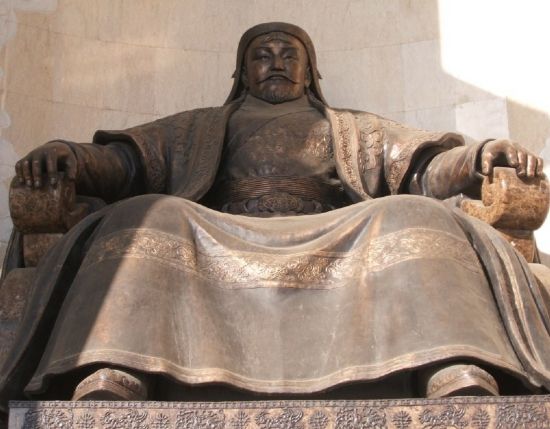Genghis Khan size has always been a topic of wonder. People want to know how tall he was and how big he looked. His size and strength were part of his legend. Let’s explore more about Genghis Khan’s physical appearance and why it mattered in history.
Genghis Khan’s height was not recorded, but he was believed to be tall for his time. Genghis Khan Size His size made him stand out among his people. This article looks at what we know about Genghis Khan’s size and why it’s important.
Genghis Khan Size:he Mystery of Genghis Khan’s Physical Build”:
Genghis Khan’s physical appearance remains shrouded in mystery, sparking endless curiosity among historians and enthusiasts alike. While historical records provide glimpses, much of what we know about his stature comes from artistic depictions and oral traditions passed down through generations. His build, often depicted as robust and commanding, reflects the strength and resilience he embodied as a leader.
In many accounts, Genghis Khan is described as towering over his contemporaries, a testament to his formidable presence on the battlefield and in diplomacy. This larger-than-life image contributed significantly to his ability to command respect and loyalty from his followers. His physical size, coupled with his strategic brilliance, helped him unify the Mongol tribes and forge one of the largest empires in history.
The physical attributes of Genghis Khan also played a symbolic role in Mongol culture and leadership. His stature was not just about height but also about the strength and endurance he exhibited during his campaigns. As he conquered vast territories, his size became synonymous with the vastness of his empire and the influence he wielded over his subjects.
Genghis Khan’s physical build continues to fascinate researchers, who speculate about his exact height and weight based on historical contexts. While precise measurements are elusive, the impact of his size on history remains undeniable. His towering figure in both literal and figurative senses remains a symbol of leadership and power centuries after his death.
Legends and Stories About Genghis Khan’s Size”:
Throughout history, legends and stories have embellished Genghis Khan’s physical size, transforming him into a mythical figure. Tales of his towering presence and formidable stature have been woven into the fabric of Mongolian folklore and beyond. These narratives often exaggerate his height and strength, portraying him as larger than life, both literally and figuratively.
In many cultures, Genghis Khan is depicted as a giant among men, with stories of his ability to single-handedly defeat enemies and conquer vast territories. These exaggerations highlight the reverence and awe in which he was held by his contemporaries and successors. His size became a metaphor for the immense power and influence he wielded over his empire.
Despite the embellishments, historians strive to separate fact from fiction when it comes to Genghis Khan’s physical attributes. While he was undoubtedly a formidable figure, the exact details of his height and build remain speculative. This discrepancy between legend and historical record adds to the intrigue surrounding his legacy and the enduring fascination with his size.
The stories about Genghis Khan’s size also reflect the cultural significance of physical stature in different societies. In many ways, his larger-than-life portrayal serves to elevate his status as a legendary leader whose influence transcends time and borders. Whether factual or mythical, these stories continue to shape our understanding of Genghis Khan and his enduring legacy.
Genghis Khan Size:Genghis Khan’s Appearance in Historical Texts”:
Genghis Khan’s appearance in historical texts offers glimpses into his physical characteristics, though details can vary. Accounts from his contemporaries and later chroniclers describe him as having a commanding presence, often emphasizing his stature and demeanor. These descriptions, while sometimes conflicting, collectively paint a picture of a leader who embodied strength and authority.
In medieval writings, Genghis Khan is depicted as tall and imposing, with a strong physique befitting his role as a warrior and statesman. His appearance was often linked to his ability to inspire fear and respect among both allies and adversaries. This physical presence played a crucial role in his ability to unite diverse tribes under the Mongol banner and expand his empire across continents.
Historical depictions of Genghis Khan’s appearance also reflect the cultural perceptions of physical attributes in different eras. Artists and chroniclers portrayed him in various forms, from majestic to fearsome, highlighting his role as a symbol of Mongol power and unity. These visual representations not only captured his likeness but also perpetuated the mythos surrounding his size and strength.
While precise details about Genghis Khan’s height and build remain elusive, the portrayal of his appearance in historical texts underscores his enduring impact on world history. His physical attributes, however portrayed, continue to fascinate scholars and enthusiasts alike, reinforcing his legacy as one of the most influential figures of the medieval world.
Genghis Khan Size:Genghis Khan’s Statues Around the World”:
Genghis Khan’s statues stand as monumental reminders of his legacy and larger-than-life persona across the globe. These statues, scattered in various countries including Mongolia, China, and even parts of Europe, symbolize his enduring influence and cultural significance. Each statue depicts him in different poses, reflecting his roles as a conqueror, leader, and founder of the Mongol Empire.
In Mongolia, the largest statue of Genghis Khan stands proudly on the Mongolian steppe, towering over visitors who come to pay homage to the legendary leader. This colossal statue captures his authoritative stance, clad in traditional Mongolian attire and mounted on horseback, evoking images of his military prowess and strategic brilliance.
In China, where Genghis Khan is viewed with a mix of admiration and caution, statues of him often portray a more subdued version, emphasizing his role in shaping Chinese history through conquest and diplomacy. These statues serve as a reminder of his complex legacy, bridging cultural divides and historical narratives between Mongolia and China.
Even in Europe, Genghis Khan’s influence is commemorated through smaller statues and monuments that highlight his impact on global history. These statues, though fewer in number, symbolize his reach beyond the Asian continent and his lasting imprint on world civilizations.
Overall, Genghis Khan’s statues not only celebrate his physical presence but also serve as focal points for cultural exchange and historical reflection. They invite visitors to contemplate his legacy, from military conquests to administrative reforms, and to ponder the enduring impact of his sizeable empire on the course of human history.
Genghis Khan Size:Debunking Myths About Genghis Khan’s Height”:
Debunking myths about Genghis Khan’s height reveals intriguing insights into how historical figures are perceived and remembered. While legends often portray him as a towering figure, the reality may be more nuanced. Historians agree that Genghis Khan was likely taller than average for his time, but specific measurements remain elusive due to the limited availability of reliable historical records.
Contrary to popular belief, there is no definitive proof that Genghis Khan was exceptionally tall. Instead, accounts of his height vary, with some suggesting he stood around six feet tall, which was considered quite imposing during the 12th and 13th centuries. However, these estimates are based on interpretations of ancient texts and artistic representations rather than concrete physical measurements.
The myth of Genghis Khan’s towering stature can be traced back to the exaggerations and embellishments that often accompany the retelling of historical events. As a revered leader who commanded vast armies and conquered vast territories, it is natural that his physical attributes would be magnified in folklore and popular culture. These myths, while captivating, highlight the challenge of separating fact from fiction in historical narratives.
Genghis Khan Size Ultimately, the truth about Genghis Khan’s height may never be fully known, but the enduring fascination with his physical stature underscores his enduring legacy as a transformative figure in world history. Whether tall or of average height, Genghis Khan’s impact on the Mongol Empire and beyond remains undeniable, shaping the course of civilizations for centuries to come.
Genghis Khan Size:Genghis Khan’s Physical Characteristics”:
Genghis Khan’s physical characteristics played a pivotal role in shaping his identity as a leader and warrior. Descriptions from historical texts portray him as possessing a robust physique, indicative of his nomadic upbringing and rigorous lifestyle on the Mongolian steppe. His stature, though not exaggerated in historical accounts, conveyed a sense of authority and strength that resonated with his followers.
Historians believe Genghis Khan had a commanding presence, standing taller than many of his contemporaries. This physical attribute, coupled with his piercing gaze and determined demeanor, contributed to his ability to inspire loyalty and obedience among his warriors. His physical appearance was a reflection of the harsh yet resilient environment in which he was raised, embodying the ruggedness and fortitude of the Mongol people.
In addition to his height, Genghis Khan was known for his endurance and agility,Genghis Khan Size traits that were essential for survival and success in the military campaigns he led. His ability to navigate vast landscapes and adapt to changing circumstances underscored his strategic acumen and leadership prowess. These physical attributes were as integral to his persona as his tactical brilliance and diplomatic finesse.
Genghis Khan’s physical characteristics continue to intrigue historians and scholars, offering valuable insights into the dynamics of power and authority in medieval Asia. His stature, both literal and figurative, remains a symbol of resilience and determination, inspiring admiration and curiosity centuries after his reign.
Genghis Khan Size:Genghis Khan’s Impact on World History”:
Genghis Khan’s impact on world history extends far beyond his physical stature, encompassing political, cultural, and economic realms. His conquests reshaped the geopolitical landscape of Asia and Europe, laying the foundation for the largest contiguous empire in history. The Mongol Empire, under his leadership, facilitated unprecedented cultural exchange, technological diffusion Genghis Khan Size, and economic integration across Eurasia.
At the heart of Genghis Khan’s legacy lies his transformative approach to governance and administration. He implemented innovative policies that promoted religious tolerance, meritocracy, and trade networks, fostering a climate of stability and prosperity within his empire. His emphasis on merit-based leadership enabled individuals from diverse backgrounds to rise through the ranks, contributing to the empire’s longevity and resilience.
Beyond military conquests, Genghis Khan’s vision for a unified Mongol Empire catalyzed advancements in infrastructure, communication, and diplomacy. The establishment of the Silk Road routes facilitated trade between East and West, enriching cultural exchanges and technological innovations. His empire served as a bridge between civilizations, Genghis Khan Size bridging gaps and facilitating cross-cultural interactions that continue to shape global interconnectedness today.
Genghis Khan’s impact on world history underscores the enduring legacy of visionary leadership and strategic foresight. His ability to harness the strengths of diverse cultures and peoples under a unified banner remains a testament to his leadership and organizational prowess. As historians continue to unravel the complexities of his reign, one thing remains clear: Genghis Khan Size influence transcends time and borders, leaving an indelible mark on the course of human civilization.
Genghis Khan Size:Genghis Khan’s Role in Cultural Exchange”:
Genghis Khan Size role in cultural exchange was pivotal in shaping the interconnected world of the 13th century and beyond. As the founder of the Mongol Empire, he facilitated unprecedented interactions between East and West,Genghis Khan Size fostering a vibrant exchange of ideas, technologies, and traditions across Eurasia.
One of Genghis Khan Size enduring legacies is his promotion of religious tolerance and cultural diversity within his empire. Unlike many conquerors of his time, he respected the beliefs and practices of different faiths, allowing religious communities to flourish under Mongol rule. This policy not only contributed to social harmony but also facilitated cross-cultural dialogue and artistic exchange.
Genghis Khan Size The Silk Road, revitalized and protected under Mongol administration, became a conduit for trade and cultural transmission between Asia and Europe. Merchants, scholars, and diplomats traversed these ancient routes, exchanging goods, knowledge, and cultural artifacts that enriched both sides of the Eurasian continent. Genghis Khan’s strategic vision for economic integration and cultural diplomacy laid the groundwork for centuries of cross-cultural engagement.
Genghis Khan Size:In addition to fostering cultural exchange through trade and diplomacy, Genghis Khan Size empire served as a catalyst for technological innovation. Advances in engineering, agriculture, Genghis Khan Size and communication were shared and adapted across diverse regions, contributing to the overall prosperity and development of Eurasian societies.
Genghis Khan Size legacy as a promoter of cultural exchange underscores his role as a bridge between civilizations,G enghis Khan Size forging connections that transcend linguistic, religious, and geographical boundaries. His empire’s legacy continues to resonate in the modern world, G enghis Khan Size reminding us of the transformative power of cross-cultural dialogue and cooperation.
Conclusion:Genghis Khan Size
In conclusion, Genghis Khan’s size and impact on history are both fascinating and complex. While we may never know his exact height, his towering presence in historical narratives reflects the immense influence he wielded over the Mongol Empire and beyond. His physical stature, whether exaggerated in legends or grounded in historical accounts, symbolizes strength and leadership that shaped the course of civilizations.
Genghis Khan Size legacy extends far beyond his physical attributes. His visionary leadership, promotion of cultural exchange, and strategic innovations laid the foundation for a globalized world where ideas and goods could travel freely. Genghis Khan Size His story teaches us that size isn’t just about height—it’s about the impact one can make on the world through courage, determination, and a vision for a better future. As we reflect on Genghis Khan’s legacy, we’re reminded of the enduring power of leadership and the profound ways individuals can shape history.








